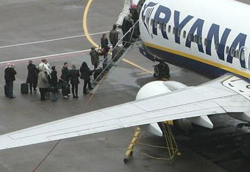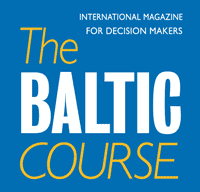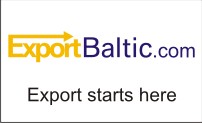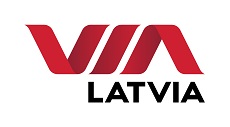Airport, EU – Baltic States, Good for Business, Tourism, Transport
International Internet Magazine. Baltic States news & analytics
Thursday, 06.11.2025, 04:05
Profits of Ryanair grew by 20% in H1
 Print version
Print version
Unit costs rose 13% due mainly to longer sectors and a 37% increase in fuel costs. Excluding fuel, sector length adjusted unit costs did not increase at all, informed BC Ryanair’s press-service.
| Half Year Results (IFRS) in euro |
Sep 30, 2010 |
Sep 30, 2011 |
% Change |
|
Passengers |
40.1m |
44.7m |
+12% |
|
Revenue |
€2,182m |
€2,712m |
+24% |
|
Adj. Profit after Tax |
€451.9m |
€543.5m |
+20% |
|
Adj. Basic EPS(euro cent) |
30.47 |
36.62 |
+20% |
Ryanair’s CEO, Michael O’Leary, said:
“We are pleased to report a 20% increase in the half year net profits to €544m. This is a testament to the strength of Ryanair’s lowest fare/lowest cost model which delivered robust traffic and profit growth despite, significantly higher oil prices, and an economic downturn in Europe. The 13% rise in ave. fares (which includes optional baggage fees) is due to slower growth, a better mix of new routes and bases, as well as rising competitor fares/fuel surcharges.
Ancillary sales rose 15% to €487m, slightly faster than traffic growth. We extended our reserved seating trial from 40 to 80 routes, and if successful we will extend it to more routes in our network. We also launched the Ryanair “Cash Passport” Mastercard prepaid card in the UK and Italy, and we intend to roll it out across the network over the coming months, to provide passengers with a no cost prepaid card for use on Ryanair.com (to avoid our optional admin. fees) and many other retailers.
 |
|---|
New routes and bases continue to perform well. Our 45th base in Manchester opened last week. Our 46th (Wroclaw – Poland) and 47th (Baden Baden – Germany) bases will start in March 2012. We also plan to open our 48th base at Warsaw (Modlin) as soon as our current negotiations with the airport have been concluded. The recession and higher oil prices continues to force competitors to consolidate, and cut capacity and routes, which creates further growth opportunities for Ryanair as European airports compete aggressively to win our route and traffic growth.
Unit costs increased 13% primarily due to longer sectors and a 37% rise in fuel costs. Excluding fuel, sector length adjusted unit costs were flat, as we continued to rigorously control costs despite a 2% pay increase, higher Eurocontrol fees, and substantially higher charges at Dublin Airport which were recently described as “insane” by Aer Lingus and “too excessive” by Etihad. We are 90% hedged for FY12 at $820 per tonne (approx. $82 pbl), up 12% on last year but significantly below current prices. We have recently extended our FY13 fuel cover and are 90% hedged for H1 at $990 per tonne ($99pbl) and 50% for H2 at $980 per tonne ($98pbl).
Ryanair’s balance sheet remains one of the strongest in the industry with €3.1bn in cash despite returning €931m to shareholders over the past three years. We have significantly reduced net debt during H1 from €709m to €372m despite another €85m share buyback. We have taken advantage of lower interest rates to fix almost 60% of our existing debt for the next 7 years at “all in” rates of just over 3.7%. Our long term dollar hedging programme will ensure that all our 35 Boeing deliveries in calendar 2011 & 2012 are funded at €/$ exchange rates of 1.43, significantly better than current rates.
We regret the decision of the Ferrovial/BAA monopoly to further delay the sale of Stansted (and instead bring forward the sale of Edinburgh), to comply with the UK Competition Commission’s 2009 breakup recommendation. While the Competition Appeals Tribunal considers this pointless judicial review, these delays allow BAA Stansted to continue to charge excessive fees and generate monopoly profits, even as Stansted’s traffic declines from 24m passengers in 2007 to less than 18m in 2011. Since 2007 Stansted airport charges have doubled to pay for a 2nd runway project which has now been abandoned. The UK Competition Commission must end these interminable delays and judicial reviews and expedite the early sale of Stansted to allow competition to deliver lower costs, and improved customer service, where Ferrovial’s high prices at Stansted and the CAA’s “inadequate” regulatory/regime has failed.
A recent 2010 Airport Survey showed that Dublin Airport fell 14 places from No. 61 to No. 75 of the world’s top 100 airports, and suffered the biggest traffic decline in 2010, with a fall of over 10%. While most other UK and European airports grew in 2010 by reducing charges, Dublin Airport increased charges by over 40% and suffered a 4th consecutive year of decline. The DAA monopoly is not fit for purpose and is damaging Irish traffic and tourism. Ireland cannot afford an uncompetitive state owned and protected airport monopoly which delivers 40% cost increases and traffic declines at the expense of Irish tourism, jobs, and the economy. We regret the failure to date by the new Government to deliver any change or reform in its airports or tourism policy. Like their predecessors the new Government has yet to deliver any change at the Department of Transport, and sadly seem to believe that protecting the high cost DAA monopoly and commissioning consultant’s reports can somehow substitute for change or transformation.
Last weeks provisional agreement to allow IAG/BA to buy BMI from Lufthansa was an expected development in the continuing consolidation process among Europe’s high fare airlines. The fact that IAG/BA will control over 60% of the shorthaul slots at Heathrow will mirror Lufthansa’s 60% share of Frankfurt slots and Air France’s 60% share of Charles de Gaulle slots. We believe this takeover will be rubber stamped in due course by both the EU and UK Competition Authorities. This will highlight, yet again, the EU’s blatantly discriminatory prohibition on Ryanair’s failed 2006 offer for Aer Lingus and the UK OFT’s more recent unjustified, and in our view out of time, investigation into a 5 year old failed merger between two Irish companies. This OFT wild goose chase and waste of public funds continues despite the fact that Aer Lingus has repeatedly ignored Ryanair’s 29% shareholding including denying our lawful EGM requests over the last 5 years. The reality is that all the evidence over the past 5 years points to the fact that (as the EU previously found) Ryanair has no control or influence over Aer Lingus.
Ryanair’s capacity cuts will mean that traffic in H2 will fall by 4%. In November, for example, we expect to report a traffic decline of 10% or almost 500k passengers as we ground up to 80 aircraft due to higher oil prices. While H1 yields were slightly better than forecast, our outlook remains cautious. Based on current Q3 bookings and very limited visibility into Q4 we now expect H2 yields will rise by up to 14%, slightly better than the 12% previously guided. Accordingly we are raising our full year net profit guidance by 10% from €400m to €440m, subject of course to the final outturn of Q4 yields”.
Note 1. Half year Sept 30, 2010 figures exclude exceptional costs of €27.9m (pre tax €31.7m) by 10% associated with the Icelandic volcanic ash disruptions in April/May 2010.
Summary half-year ended September 30, 2011
Adjusted profit after tax increased by 20% to €543.5m compared to €451.9m in the half-year ended September 30, 2010 primarily due to a 13% increase in average fares and strong ancillary revenues, offset by a 37% increase in fuel costs. Total operating revenues increased by 24% to €2,712.4m as average fares rose by 13%. Ancillary revenues grew by 15%, faster than the 12% increase in passenger numbers, to €486.5m due to an improved product mix and higher internet related revenues. Total revenue per passenger, as a result, increased by 11% whilst Load Factor remained flat at 85% during the period.
Total operating expenses increased by 26% to €2,061.9m, primarily due to an increase in fuel prices, the higher level of activity and operating costs associated with the growth of the airline. Fuel, which represents 44% of total operating costs compared to 40% in the prior period, increased by 37% to €907.0m due to the higher price per gallon paid and a 20% increase in the number of hours flown. Unit costs excluding fuel increased by 6% and sector length adjusted, they remained flat. Including fuel unit costs rose by 13%. Operating margin decreased by 1 point to 24% whilst operating profit increased by 19% to €650.5m.
Adjusted net margin was down 1 point to 20%, compared to September 30, 2010.
Earnings per share for the period were 36.62 euro cent compared to adjusted earnings per share of 30.47 euro cent at September 30, 2010.
Detailed discussion and analysis for the Half-year ended September 30, 2011
Adjusted profit after tax increased by 20% to €543.5m primarily due to a 13% increase in average fares and strong ancillary revenues offset by higher fuel costs. Total operating revenues increased by 24% to €2,712.4m primarily due to a 13% increase in average fares, and a 12% increase in passenger numbers. Fuel, which represents 44% of total operating costs compared to 40% in the prior year, increased by 37% to €907.0m due to a higher price per gallon paid and a 20% increase in the number of hours flown. Unit costs excluding fuel rose by 6%, when adjusted for sector length, unit costs remained flat. Including fuel unit costs rose by 13%. Operating margin, as a result of the above, decreased by 1 point to 24%, whilst operating profit increased by 19% to €650.5m.
Total operating revenues increased by 24% to €2,712.4m primarily due to a 13% increase in average fares and a 12% increase in passenger numbers to 44.7m.
Total revenue per passenger increased by 11% primarily due to a 13% increase in average fare per passenger.
Scheduled passenger revenues increased by 27% to €2,225.9m due to a 12% rise in passengers and a 13% increase in average fares. Load factor remained flat at 85%.
Ancillary revenues increased by 15% to €486.5m, faster than the 12% increase in passenger volume, due to an improved product mix and higher internet related revenues.
Total operating expenses increased by 26% to €2,061.9m due to the 37% increase in fuel costs and a 6% increase in sector length.
Staff costs increased by 17% to €222.5m due to a 12% increase in sectors flown and a companywide pay increase of 2% granted in April 2011.
Depreciation and amortisation increased by 19% to €155.8m due to a combination of the increased level of activity and a higher number of ‘owned’ aircraft in the fleet this period (September 30, 2011: 221) compared to the half-year ended September 30, 2010 (199).
Fuel & oil costs increased by 37% to €907.0m due to higher fuel prices and the increased number of hours flown.
Maintenance costs increased by 12% to €49.3m due to the increased level of activity and higher costs arising from the launch of new bases.
Aircraft rental costs fell by 12% at €43.5m, due to lower lease costs on newer aircraft and a decrease in the weighted average number of leased aircraft.
Route charges rose by 22% to €271.5m due to the increased number of sectors flown, the longer sector length and higher average rates charged by Eurocontrol.
Airport & handling charges increased by 18% to €316.3m, due to the 12% increase in passenger volumes, higher airport charges at Dublin airport, increased airbridge charges in Spain, and the mix of new routes and bases launched.
Marketing, distribution & other costs increased by 34% to €96m, reflecting higher marketing spend per passenger due to increased activity and increased onboard product costs reflecting the higher level of sales.
Operating margin decreased by 1 point to 24% due to the reasons outlined above and operating profits have increased by 19% to €650.5m.
Finance income increased by 65% to €21.9m primarily due to improved deposit yields on longer dated deposits.
Finance expense increased by 26% to €54.8m due to the higher level of debt and the rise in interest rates in the period compared to the period ended September 30, 2010.
Adjusted net margin was down 1 point to 20%, compared to September 30, 2010.
Balance sheet
Gross cash increased by €184.0m to €3,124.6m and the Group generated cash from operating activities of €456.6m which funded net capital expenditure of €26.5m, debt repayments and an €85.1m share buy back programme. Gross debt decreased by €152.6m to €3,496.8m. Net debt has fallen from €708.8m at March 31, 2011 to €372.2m at the period end.
Shareholders’ equity increased by €222.9m in the period to €3,176.6m due to the net profit after tax of €543.5m and the issue of new shares, associated with the employee share option programme, of €2.8m. These were offset by the €85.1m share buy back and the impact of IFRS accounting treatment for derivatives, available for sale financial assets and stock option grants.
Reconciliation of profit for the period to adjusted profit for the period
|
|
Half-year Ended |
Half-year Ended |
Quarter Ended |
Quarter Ended Sep 30, 2010 |
|
|
€M |
€M |
€M |
€M |
|
|
|
|
|
|
|
Profit for the financial period |
543.5 |
424.0 |
404.2 |
330.3 |
|
|
|
|
|
|
|
Adjustments |
|
|
|
|
|
Icelandic volcanic ash related expenses |
- |
31.7 |
- |
(18.3) |
|
Tax on Icelandic volcanic ash related expenses |
- |
(3.8) |
- |
1.4 |
|
Adjusted profit for the period |
543.5 |
451.9 |
404.2 |
313.4 |
Principal risks and uncertainties
Among the factors that are subject to change and could significantly impact Ryanair’s expected results for the remainder of the year are the airline pricing environment, fuel costs, competition from new and existing carriers, costs associated with environmental, safety and security measures, actions of the Irish, UK, European Union (“EU”) and other governments and their respective regulatory agencies, fluctuations in currency exchange rates and interest rates, airport access and charges, labour relations, the economic environment of the airline industry, the general economic environment in Ireland, the UK, and Continental Europe, the general willingness of passengers to travel and other economic, social and political factors and flight interruptions caused by volcanic ash emissions or other atmospheric disruptions.








 «The Baltic Course» Is Sold and Stays in Business!
«The Baltic Course» Is Sold and Stays in Business!

